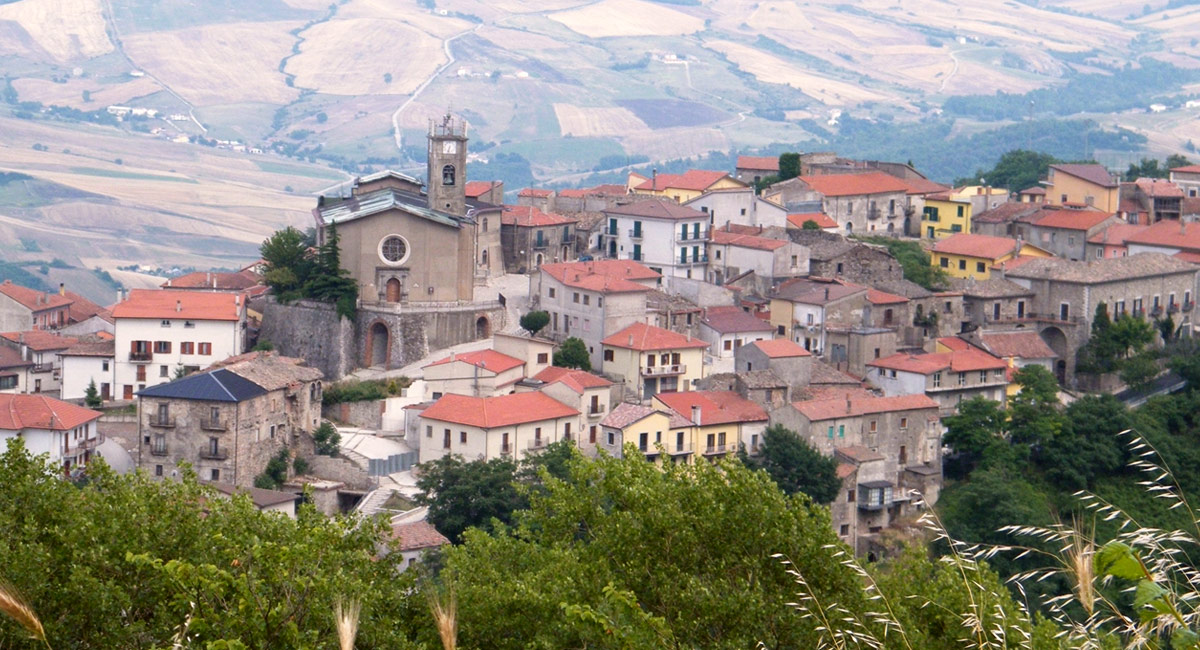ITINERARIES IN THE VALLEYS OF GOOD LIVINGVallata

A transit point for sheep tracks, part of the traditional transhumance tradition on the Pescasseroli-Candela route, the municipality of Vallata sits on a gentle hill at the foot of the town of Trevico. Surrounded by greenery and crisscrossed by various waterways, the town boasts numerous woodlands, such as Terzo di Mezzo near Serrapolla and Coste Santo Stefano below Trevico. The Calaggio and Ufita rivers pass through the town, and it boasts an artificial lake in Iazzano. The area has been inhabited since prehistoric times by the Oscan-speaking Hirpini, who settled near the waterways, as evidenced by the necropolises dating back to that period. Finds in the area include terracotta vases and amphorae, gold and silver coins, sculpted capitals, and clay lamps. Finds in the Mezzane Perazze district date back to the Roman period. There is no consensus regarding the origin of the name, believed by some to derive from the town's geographical location, a dominant position defending the two underlying valleys of the Calaggio and Ufita, while others believe it to be linked to the name "ballatam", Italianized to Vallata. The current town arose around 950 AD following the barbarian invasions. The first mention of the town is linked to a document by Pandolfo di Vallata dating back to 1120. A fiefdom of the Barony of Vico under the Normans, it passed over the centuries to the Angevins, the Del Balzo family, and finally the Orsini family. The battle of 1496, which involved the people of Vallata and the forces of the Marquis of Mantua, Francesco Gonzaga, is famous. Gonzaga, at the head of the army of the League of Italian Princes, descended on the Kingdom of Naples to re-establish the status quo ante following the retreat of Charles VIII. Only the people of Valladolid, on that occasion, valiantly resisted the attack of the Mantuan army, but the vastly superior Gonzaga forces prevailed over the local population, who were largely pillaged and killed. The city has numerous cultural and religious traditions, linked to ancient cults and propitiatory rites, such as the Good Friday procession.
ITINERARIES IN THE VALLEYS OF GOOD LIVINGPlaces of Interest
Mother Church of St. Bartholomew the Apostle
The mother church is located in the historic center of Vallata and is dedicated to the patron saint, Bartholomew the Apostle. Dating back to the year 1000, according to some theories, it has been rebuilt several times over the centuries due to the various earthquakes that have struck the town. The interior features three naves, a lateral nave interrupted by the base of the Romanesque bell tower with a wooden ceiling. Above the majestic high altar is an enormous canvas depicting the martyrdom of Saint Bartholomew, a work attributed to Lanfranco, as is the statue of the saint venerated in the same church. The presbytery altar is made from pieces of the old altar; the most precious element is undoubtedly the marble sarcophagus, which features an 18th-century Neapolitan marble medallion depicting the patron saint. The façade is characterized by an artistic stone portal and a large rose window, approximately 3 meters in diameter, depicting the Virgin Mary.
Church of San Vito
The church of San Vito is located at the southern end of the town and was presumably built between the 13th and 15th centuries with stone and lime. The chapel's high altar, which houses a full-length bust of the saint, was created in 1777, as indicated at the base, while the side altars, dedicated to Saints Cajetan and Andrew, were built in 1793. The church's current appearance is the result of renovations undertaken since the 1990s, which also brought to light the structure's stone cladding. According to tradition, the statue kept in the chapel is never carried in procession for fear that the saint would turn against it with a storm of stones. For this reason, a half-length statue kept in the mother church is carried during the procession.
Church of Santa Maria
The church of Santa Maria was built in the early 1930s on the hill of the same name, approximately 950 meters above sea level, by popular demand following the discovery of several precious artifacts on the hill, including a crucifix and a painting of the Madonna, both dating back to the 15th century. The construction followed instructions provided by a certain Giovanni Antonio Crincoli, who, according to tradition, received them in a dream from the Virgin herself. In the decades that followed, the building underwent rapid decline and remained abandoned for several years. Only in the late 1990s, thanks to the commitment of a citizens' committee, did reconstruction and restoration work begin on the church, funded entirely by the citizens through the events held on the hill in August, such as festivals and musical performances. A recently restored wooden statue of the Virgin is venerated inside the church.

